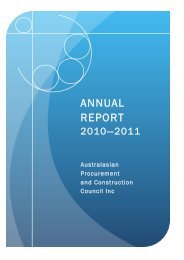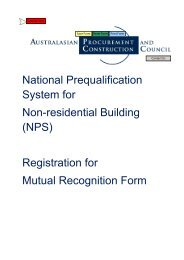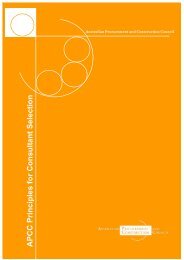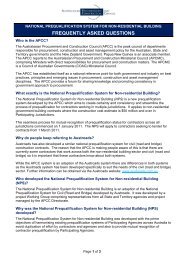Improving Security of Payment Building and Construction Industry
Improving Security of Payment Building and Construction Industry
Improving Security of Payment Building and Construction Industry
- No tags were found...
You also want an ePaper? Increase the reach of your titles
YUMPU automatically turns print PDFs into web optimized ePapers that Google loves.
5. Pro<strong>of</strong> <strong>of</strong> <strong>Payment</strong> Page 58National Public Works Council Inc<strong>Improving</strong> <strong>Security</strong> <strong>of</strong> <strong>Payment</strong> in the <strong>Building</strong> <strong>and</strong> <strong>Construction</strong> <strong>Industry</strong>5.2 BackgroundThere are various options which this Consultancy considers in relation to the viability <strong>of</strong>pro<strong>of</strong> <strong>of</strong> payment mechanisms (other than statutory declarations) as a security <strong>of</strong> paymentmeasure.Pro<strong>of</strong> <strong>of</strong> payment as a security <strong>of</strong> payment measure is predicated upon the concept that aSubcontractor be paid at the same time as or before a Head Contractor receives payment fromhis Principal.Most st<strong>and</strong>ard form building contracts contain the Statutory Declaration form <strong>of</strong> pro<strong>of</strong> <strong>of</strong>payment, but the anecdotal evidence is that while they are relatively simple to administer,Statutory Declarations are not considered effective because <strong>of</strong> the many loopholes that areavailable in making a declaration in respect <strong>of</strong> payment.A variation on this approach is the use <strong>of</strong> Records <strong>of</strong> <strong>Payment</strong>. Prior to the Head Contractorbecoming entitled to receive any progress payment from the Principal, the Head Contractormust obtain a receipt from each Subcontractor that all monies due <strong>and</strong> payable have beenpaid. This is a relatively effective system, but requires significant administrative costs forboth Principals <strong>and</strong> Head Contractors. However, the system is open to abuse by disputation<strong>and</strong> its success depends on the record-keeping skills <strong>of</strong> all the contracting parties.As a consequence, we explore various alternatives.5.3 Queensl<strong>and</strong> Build ApproachThe first option is the "Queensl<strong>and</strong> Build Approach" ("QBA") which requires the HeadContractor to obtain from the Subcontractor a signed acknowledgment that payment has beenreceived <strong>and</strong> the Head Contractor is then required to submit to the Principal a statement tothat effect. The Head Contractor also identifies those Subcontractors who have not lodgedsuch an acknowledgment prior to further payments being made by the Principal under theprimary contract to the Head Contractor.The QBA contractual arrangements were implemented by QBuild Project Services, which isa business unit <strong>of</strong> the Queensl<strong>and</strong> Administrative Services Department. The QBA wasimplemented on Department projects from 1 July 1992 <strong>and</strong> further amended in October 1993.The QBA is only m<strong>and</strong>atory for Departmental contracts <strong>and</strong> accordingly, is optional forprivate contracts.The contractual arrangements rely on Subcontractors being proactive in reporting to therelevant Department a default <strong>of</strong> payment by a Head Contractor <strong>and</strong> also rely onSubcontractors exercising their rights under the Queensl<strong>and</strong> Subcontractors' Charges Act("SCA") immediately they are able to do so. The onus is on the Subcontractors recoveringmonies from defaulting Head Contractors through either the provisions <strong>of</strong> the SCA or mutualagreement with the respective Head Contractor.In summary, the QBA is as follows:



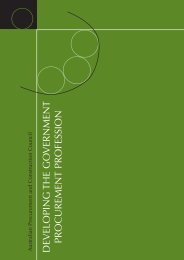
![NATIONAL COST ADJUSTMENT PROVISION EDITION 2 [NCAP2]](https://img.yumpu.com/48266135/1/184x260/national-cost-adjustment-provision-edition-2-ncap2.jpg?quality=85)



